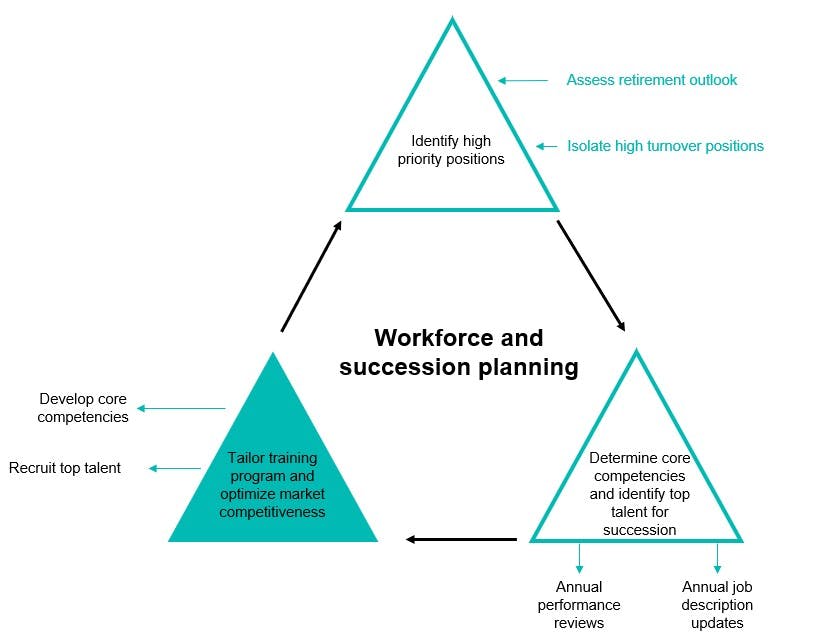Workplace flexibility appeal: The typical employee that participates in a telecommute program is male, college-educated and 45 years or older. Millennials are not the only generation who find flexible work environments appealing. Organizations that allow telecommuting are creating a work environment that has appeal across generations.1

Workforce and succession planning – part 3: training and competitiveness
Workforce and succession planning is a continual process for government entities, public utilities, and not-for-profit organizations focused on supporting strategic success through human capital management.
Parts one and two of Baker Tilly’s three-part workforce and succession planning series describe how organizations should identify high-priority “critical” positions, pinpoint top talent and build a talent bench to support the critical positions.
That’s all great, but what happens if your public or not-for-profit organization doesn’t have sufficient internal candidates to fill all critical positions and not all internal candidates possess proficiency in the necessary core competencies?
In part three of the series, we dive into building a tailored training program to enhance skillsets and structuring your organization to optimize market competitiveness. The diagram below provides an overview of the workforce and succession planning process and the steps that tie into a successful program.

Step 1: Building a training program to support succession planning
Identify individual competency gaps
When you’ve filled your talent bench with top-performing candidates, it’s then time to identify any gaps between the competencies candidates currently have, and the competencies required to fill a critical position. Hiring managers should refer to both the job description of the critical position and the job description of the employee’s current position. It may also be helpful to reference job descriptions of any past positions the candidate has held.
Creating and using a talent profile form can help track development progress, the critical positions for which the candidate is eligible, and the employee’s aspirations, experience, and education. The form acts as a central tracking source of the employee’s progression and should be shared and updated with the employee. Additionally, having open and continued conversations with employees to understand their career goals and communicating career opportunities is critical for a successful workforce and succession plan. Government entities, public utilities, and not-for-profit organizations need to know if an employee’s aspirations align with potential succession planning candidacy; an employee may be content in their current position and have no intention to advance, or a candidate may wish to advance, but not into a position identified during the organization’s assessment. Open communication allows both parties to better understand how they can support each other’s goals.
Create employee-specific action plans, aggregate competency gaps organization-wide and identify training
When the supervisor and candidate identify individual competency gaps, an action plan should be created to develop skills to address each gap. Supervisors should share action plans with the human resources and learning and development departments (if they exist) so all parties are informed of existing action plans. Upon review of the competency gaps across the organization, human resources or learning and development can establish a strategic training program to identify training that can be efficiently and consistently offered through internal or external training, and work with supervisors to create targeted training opportunities for technical and educational development as needed. For example, if a candidate must have leadership training prior to being eligible for a critical position, then receiving this training should be incorporated into the candidate’s training plan for that year.
Incorporate training plans into upcoming budget
Development of the training plans should occur prior to budget planning. Learning and development or human resources departments need to build the necessary training costs into their budgets and ensure training will be available to those who need it.
Step 2: Optimize market competitiveness
Candidates may leave, or your organization may not have sufficient internal resources to fill vacated critical positions. With approximately 30 percent of public sector employees expected to retire in the next five to 10 years —on top of normal attrition rates — your organization needs a recruitment strategy for critical positions. To support the recruitment strategy, consider undertaking one or two special projects a year to update policies and practices to make small, incremental changes that boost your organization’s competitiveness in the marketplace. Policies and procedures that may need modernizing include:
On a larger scale, system capabilities and functions can have a significant impact on the quality and skillset of employees an organization can retain. Employees increasingly expect to work in environments where transactions are automated and digital and operations move at a quicker pace. In addition, with system capabilities to capture and manipulate large quantities of data, there is a high demand for candidates with strong computer analytic skills. As such, technology and system upgrades can be a differentiator when trying to recruit and retain top talent.
Furthermore, in part two, we recommended reviewing job descriptions to ensure they reflect the necessary core competencies of the critical positions. During that review, it is also a best practice to annually assess the compensation structure of your organization to ensure you can recruit qualified talent for critical positions.
Step 3: Review and repeat
Workforce and succession planning is a cyclical, ongoing process for government entities, public utilities, and not-for-profit organizations. A formal succession planning program is crucial to aid in identifying critical and at-risk positions. Each year, critical positions and the talent bench to fill those positions should be re-evaluated. New employees should be considered, and existing employees should be re-considered. Core competencies must be revised as needed, and the effectiveness of training and recruitment plans should be assessed. At year-end, the process starts over again. Many components of workforce and succession planning can be incorporated into pre-existing practices within your organization, and as it becomes second nature in the culture, operational stability will increase.
Check out the full workforce and succession planning series:
For more information on this topic, or to learn how Baker Tilly workforce and succession planning specialists can help, contact our team.
1"Latest Telecommuting Statistics," GlobalWorkplaceAnalytics.com, June 2017.
